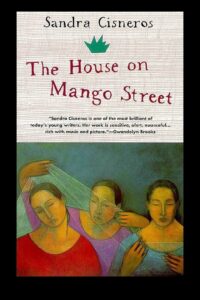The House on Mango Street by Sandra Cisneros
Book: The House on Mango Street
Author: Sandra Cisneros.
Publication: Vintage
Pages: 144
Price: click the link
Author Introduction:
Sandra Cisneros ( born 1954 ) is a Mexican-American writer. She is best known for her debut novel, The House on Mango Street (1983) which we are going to discuss today. Her short story collection is known as Woman Hollering Creek and Other Stories (1991). Her works are written against the backdrop of cultural hybridity, gender role, poverty, migration and economic inequality.

As Sandra Cisneros is an American with a Mexican root she faces the tug of war of identity between these two cultures- Mexican and American. Her own childhood experiences formed the basis of Mango Street. Like Esperanza she grew up within a large family, being a daughter in a family of six brothers. The constant migration of her family between Mexico and the United States instilled in her a sense of insecurities and not belonging anywhere.
The House on Mango Street has sold over six million copies and has been translated into over twenty languages.
The House on the Mango Street
The writer in the Introduction tells she started writing this novel in the spring of 1977, in Iowa City at the age of 22 and when she finished it she was 38 years old.
“When I began The House on Mango Street, I thought I was writing a memoir. By the time I finished it, my memoir was no longer memoir, no longer autobiographical. It had evolved into a collective story peopled with several lives from my past and present, placed in one fictional time and neighbourhood—Mango Street.”
The desire to escape Mango Street exists in every human heart. It is a dream, a desire, to soar above the mundane humdrum ways of life. Mango street symbolises the suffocating existence that we live in and our unfulfilled dreams to get rid of it.
Story Line:
“A story is like a Giacometti sculpture. The farther away it is from you, the clearer you can see it.”
With a detached but speculative heart, Sandra Cisneros narrates her story and sketches her characters and their lives.
The novel is divided into small anecdotes and chapters. Through them, Esperanza brought the world to the readers.
Dreamhouse of Esperanza
A house is not only four walls, a roof and some bricks. A house is an identity. It signifies your place in society. But Esperanza never feels aligned with her house.
“We didn’t always live on Mango Street. Before that, we lived on Loomis on the third floor, and before that, we lived on Keeler. Before Keeler it was Paulina, but what I remember most is Mango Street, sad red house, the house I belong but do not belong to.
In Esperanza’s dream, there was an ideal house. Her parents told her that one day they would be moved to a new house that would be their own, no more rented house, no more the ranting of the house owner.
There would be running water, stairs, a basement, at least three washrooms. There would be a big yard, grass lawn, trees.
“This was the house Papa talked about when he held a lottery ticket and this was the house Mama dreamed up in the stories she told us before we went to bed.”
Esperanza’s dislike of her name:
Esperanza was insecure about her long uncommon name. Her classmates joke about her name.
‘Esperanza’ is a Spanish name meaning too many letters, sadness, waiting. In English, it means ‘hope’. It is like the number nine. Again it was a Mexican record that Esperanza’s father used to play at the time of his shavings. Esperanza was the name of her great-grandmother. And to her utter dismay, there was no pen name for Esperanza. Her sister ‘Magdalena’ became Nenny at home. But that was not possible for her name. That’s why she loved to baptize under a new name.
The uniqueness of her name signifies her importance in the novel.
The neighbourhood girls whom Esperanza befriended:
Esperanza started mixing with the neighbouring girls. Cathy became her friend but for a short time as her father moved away to France. Then she befriended Rachael and Lucy who offered her a share of a bicycle at five dollars. There was a junk shop and an old man worked there. When Cathy’s family left their house Meme Ortiz moved there. His real name is Juan.
 The House on Mango Street by Sandra Cisneros
The House on Mango Street by Sandra Cisneros
Women in Mango street
Esperanza though a teenage girl speaks out on the more mature subject matter. As she watches her neighbours and particularly the women, she felt they are trapped, powerless and exploited.
Sally before marriage was oppressed by her father- brutally beaten and suppressed. She married suddenly at a younger age to escape the torture of her father and became free. But her husband stepped into the same shoes. She was not allowed to call or meet anymore and go anywhere.
Narrative Style:
The novel has a unique narrative style with its poetic intonation and anecdotic style of division.
Musical Flow
In the introduction, Sandra Cisneros pointed out that this novel is ‘a cross between fiction and poetry’. There is lyricism echoing in every line and paragraph. It possesses the economy of poetic expression. The narrative technique is poetic, imagistic, the language flows like music. It is more like a book or poem than a typical novel. Again like poetry, the language is packed with multiple meanings. The words and the sentences seem drawling like a dream.
A string of vignettes:
The chapters are small like fables. They are the vignettes, i.e. short pieces of writing, music, acting etc that clearly express the typical characteristics of something.
This novel, being a string of vignettes, does not follow any chronological plot. They are the mere everyday life of the inhabitants reflected through the eyes of Esperanza. Some chapters consist of only one paragraph.
As the plot is not linear one should not expect a conventional storyline. It sometimes seems that I am reading many stories within a story and that’s interesting.
Coming of age novel:
The novel can be termed a Coming of age novel like Purple Hibiscus of Chimamanda Ngozi Adichie. The House on Mango Street focuses on the development of Esperanza from childhood to maturity while Purple Hibiscus is the story of Kambili’s growing up.
Themes:
-
Struggle for Identity:
Esperanza wanted to change her name. She felt displaced. She struggles to cope with the neighbourhood and her world. She felt the oddity of her name causing her alienation from others.
-
Oppression of Patriarchy:
Friends of Esperanza funds freedom in marriage.
Sally before marriage was oppressed, beaten and suppressed by her father. She married suddenly even before she passed her eighth grade to escape the torture of her father and became free. But with her marriage, she entered the same circle of patriarchy.
Esperanza did not think of marriage as an escape but entering into a new trap of oppression. In mango street, the houses belonged to the men and the women belonged to the houses where they were ascribed to their prescribed roles as mother and wife. They were limited within the four walls. they keep watching the world moving around through their window.
-
House:
In Esperanza’s heart, there was a dream house. They had to move from house to house before they settle on Mango Street.
But the house on Mango Street is not up to that mark of imagination. It was small its window was small so small that it seemed, ‘they were holding their breath.’ The bricks were crumbling and the door was so swollen that one had to push hard to get in.
“…but what I remember most is Mango Street, sad red house, the house I belong but do not belong to.”
Throughout her life, Esperanza hopes for a house, a house of her own, a cosy warm house:
“Not a man’s house. Not a daddy’s. A house all my own. With my porch and my pillow, my pretty purple petunias. My books and my stories. My two shoes waiting beside the bed. Nobody to shake a stick at. Nobody’s garbage to pick up after. Only a house quiet as snow, a space for myself to go, clean as paper before the poem.”
-
The Plurality of Voices:
Though the novel is narrated by a single person, Esperanza, the voice is not keyed in a single string…Esperanza speaks for the world…world beyond the precincts of Mango Street. The plurality of voices within a single voice is the most inimitable feature of this novel.
-
Language:
“The language in Mango Street is based on speech. It’s very much an antiacademic voice—a child’s voice, a girl’s voice, a poor girl’s voice, a spoken voice, the voice of an American-Mexican. It’s in this rebellious realm of antipoetic”
the language is lucid but concise, perfect for an intriguing plot.
-
Isolation, loneliness, longing:
The characters in the house of mango street are lonely,
-
Struggle for freedom:







Pingback: Whereabouts by Jhumpa Lahiri
Pingback: Angel's Ashes by Frank MC Court, Book review, blogalvina.com
Pingback: The Awakening by Kate Chopin Book Review - Blog Alvina